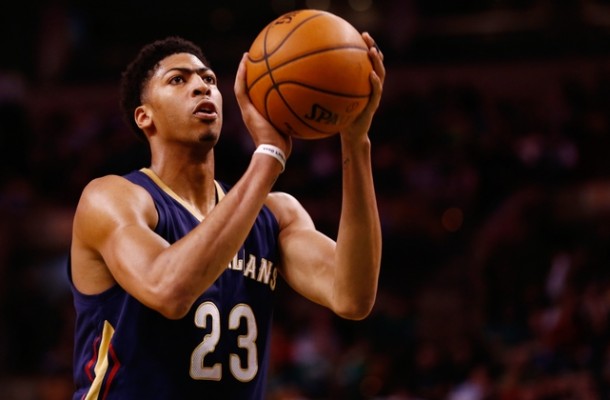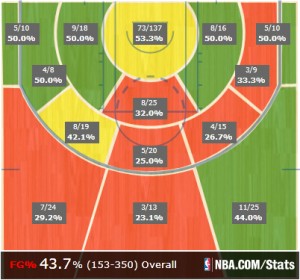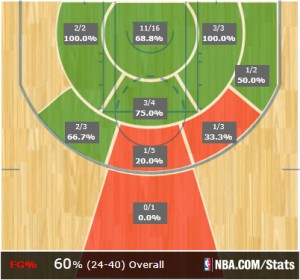The New Orleans Pelicans made the playoffs for many reasons (and not all of them are named Anthony Davis). One of the main reasons is that they had a top-10 offense for most of the year, finishing with an offensive rating of 108.2, good for 8th in the league. The Pelicans offense rated just behind the defending champion San Antonio Spurs and just ahead of the Portland Trailblazers and Chicago Bulls. In other words, the Pelicans have a high powered offensive attack which includes Davis (who nearly broke PER at one point this season), Tyreke Evans, bombers Ryan Anderson and Eric Gordon, and when healthy, Jrue Holiday.
The Pelicans’ offense shoots a decent effective field goal percentage (eFG%) at 50.1%, which is good for 11th in the league. The team also shoots at a strong clip from beyond the arc, making 37% of their three pointers, good for 4th in the league. The team owns the paint, scoring 45 points per game in there (8th) and has a strong Assist-to-Turnover ratio at 1.66 (8th). That being said, if the Pelicans are a speeding car, the wall they just ran into might actually be The Great Wall of China.
Despite the Golden State Warriors reputation as an offensive juggernaut, (which they are) the Warriors rate as the top defensive team in the league (and they have been for most of the year). Which begs the question, how did the Warriors build the top defense in the NBA, after being a sieve two years ago, and middle of the pack last year? They have two guys with legitimate claims for being Defensive Player of the Year, and both of them have been in Oakland the entire time. So what has happened? The answer is, not changing a single player, but having each player improve, and tweaking the system. The Warriors block the second most shots per game in the league (humblebrag: the Pelicans lead the league). Secondly, the Warriors had the fourth most steals in the league. Not only that, but the Warriors lead the league in points off turnovers, averaging 19.7 points per game. The defense feeds the offense.
Dubs’ Defense
The Warriors have grown massively. Through the insecurity that high-jacked Mark Jackson’s coaching career, one positive thing came out. Instead of listening to defensive guru Mike Malone (lead assistant coach at the time), who wanted the team to “show” on picks, Jackson listened to assistant coach Darren Erman who preferred the “ice” form of pick and roll defense. “Showing” on pick and rolls requires the big man to hedge out and prevent the ballhandler from turning his shoulder and driving into the paint. It is effective in limiting dribble penetration, but leaves an easy out for the ballhandler by finding the roll man. The big man then has to scramble back, which sets off a lot of rotations and requires a lot of effort from the defense. This is how the Pelicans cover the pick and roll (hilariously enough this is a holdover from Mike Malone being an assistant coach here in ’10-’11, when he helped the Pelicans have the greatest defensive improvement that year, which landed him the Warriors job.)
But with Andrew Bogut on the team, Erman’s preference of ‘ice” made more sense. Ice requires the ballhandlers’ defender to position his body between the ballhandler and the pick (some teams refer to this as “blue”). The big man in this scenario sinks, and the defense pushes the ballhandler away from the pick. This system doesn’t require the amount of rotations that having a big man showing does. With the two defenders playing the ballhandler in this way, they cut off passing angles to the roll man while keeping the ball handler in front of them and shrinking the court. Essentially the ballhandler can either dribble into the teeth of the defense, or pass the ball out. Either way, the defense hasn’t been pierced, and no open look has been found.
The Warriors, who have a nucleus that has mostly been together for three years, have learned to execute this near perfectly. More than the Warriors’ propensity to switch, their ability to maneuver around pick and rolls in this way allows the team to keep their defenders covering the perimeter while also always having Bogut cover the paint. The Warriors hold teams to 49.3% shooting at the rim, third lowest in the NBA. Bogut, like Marc Gasol pre-DPOY award, does all the little things that don’t get noticed. His ability to block shots, take charges, and play both on and off the ball defense all help anchor the best defense in the NBA.
While Norris Cole is able to use the pick on this play, Steph Curry hustles after him, cutting off Cole’s passing lane. Cole attacks the rim (actually driving so fast that Davis doesn’t have a chance to cut to the basket in time to be a threat for a lob) and meets Bogut. Bogut had seven blocks in that first half alone, and this one turned into a fastbreak and two points the other way.
Besides that the Warriors have cleared up defensive weaknesses via player development. Curry gets all the credit for improving his defense, but David Lee has also made huge strides as well, no longer being a complete liability on defense. The team has also seen Draymond Green go from being a tweener to one of the best post defenders in the league, someone who could cover anyone from a point guard to a power forward.
Which leads to the element of the defense that has gotten all the attention for the Warriors, their ability to switch. Zach Lowe referred to it as “switchcraft” earlier in the season. The Warriors often play three different wings that can interchangeably switch. Klay Thompson, Andre Iguodala, Harrison Barnes, Green, Shaun Livingston and Justin Holiday can all cover wings, point guards, and most power forwards. The Warriors can have any of those guys switch at will, never allowing a team to find a crack in the seams via an off-the-ball screen or pick and roll. Coach Steve Kerr doesn’t like the team to overuse this but when the shot clock starts winding down, Kerr trusts his team to make the reads necessary to help stall an offense out. If a team switches with four or five seconds left in the shot clock, the offense isn’t going to be able to take advantage of any mismatches. And that’s what the Warriors are counting on.
The point of this defense is to never allow the ballhandler to have a clear lane to the basket without ever having to take away a defender from another player. With the wings being able to switch at will, and Bogut hovering in the paint, the Warriors don’t give up many open 3s, or shots at the rim. As Green is quoted in the Lowe article, “Good luck hitting enough midrange jumpers to beat us…You won’t.”
Pelicans Attack
So how do the Pelicans attack this? The shot chart for the four games reveals that the Pelicans shot well when they got the shots they wanted.
The problem was that the Warriors are really good at taking away the shots you want. The Pelicans only shot 20 shots total from the corner 3s in the four games they played against the Warriors. The Warriors also showed their will in the paint, where the Pelicans shot 53.3%. That is better than most teams fare against this unit, but that is not up to par for the Pelicans, who make a living in the paint. The Pelicans also shot atrociously from the midrange. Part of that is that Davis missed two of these games, and Jrue Holiday missed two as well. With those two guys out the Pelicans pick and roll game is not the same, and that takes away the quality of shot. The Pelicans won’t win this series by settling for midrange jumpers, but it will be interesting to see if Davis, Evans, and Holiday (and Cole?) can get hot enough to force the Warriors to bend their rules a bit at one point.
The best way for the Pelicans to beat the Warriors defense (and the best way for the Pelicans to do anything) is through Davis. Running horns through Davis is a nightmare situation for the Warriors. Having a big that can get to the rim in one step, shoot over Bogut, (or draw Bogut away from the rim if he is covering Davis), helps rearrange the entire Warriors defense. Whoever is covering Davis will not want to leave him for fear of his lethal jumpshot and ability to gallop to the rim. It also allows Davis to feed the perimeter players, who can curl around him and catch the ball with momentum, possibly beating their defender and racing Bogut to the rim.
For all their defensive prowess, and for having two post players who will be All-NBA Defense, the Warriors haven’t been able to stop Davis at all. He has shot 24-40 from the field in two games, and has decimated the Warriors from inside. His shot chart is a couple of plots of grass away from being a perfect lawn.
If the Warriors put Bogut on him, they take him away from the rim. If they put Green on him, Davis can look over him and play de facto playmaker Marc Gasol style, with the option to pass or shoot over the smaller defender. In the fourth quarter of the April 7th victory over the Warriors, there is a play where Davis gets the ball out close to the three point line. He keeps the ball and just speeds by Lee for the and-1. The Warriors don’t have an answer for this (nobody does.)
Even in basic pick and roll situations, he can be a monster. Whether he is popping for open midrange jumpers, rolling hard to the rim and beating everyone there, or slipping the pick before the switch is set, Davis can eviscerate this defense. The Warriors are allowed to freelance on defensive switches, but Davis can have them second-guessing themselves, which for the fastest defense in the league, can be a problem.
But the Pelicans don’t have a cheat code like Bo Jackson in the old Tecmo Bowl games that will allow Davis to play the entire game and never get tackled or fatigued. And that’s ok, the Pelicans have other options when it comes to breaking down the Warriors defense. While Omer “No Ice” Asik helps defensively, he has struggled mightily on offense against the Warriors, going 8/19 at the rim. Anderson opens up this offense, and challenges the Warriors in ways they may not be able to handle. While the Warriors consider themselves a strong team as far as picking up players in transition, Anderson found a couple of open threes by trailing the play on delayed fast breaks in the two teams lasting meeting. The Warriors like to have Barnes play the “power forward” position on the second units, in order to afford the team a little more space with Livingston and Iggy out there, but none of those guys can cover Anderson. While Anderson did have some “adventurous” passes during the game, he did have a beautiful isolation against Iggy, where he backed him down on the left block and banked a shot in. If Anderson forces the Warriors to leave two bigs in at all times, the Warriors “switchcraft” will be negated, and a huge chess piece would be off the board for the Warriors.
The Pelicans most commonly used offensive play features Anderson as well. The Bunch Play (which got a shoutout from Lowe as well), has Davis set a high screen for the ball handler. Davis’ man will get hit with a back-screen, causing the entire defense to go code red, while Anderson will cut from the paint to the three point line. Anderson’s man has to make the decision of whether to stay in the paint, and clean up whatever comes his way (the ballhandler/a cutting Davis looking for an alleyoop/locusts) or depart the paint and cover Anderson. Rarely do they cover Anderson in time, and if Bogut is the one sinking to cover RyNo, I expect a three coming out of that play every time.
Evans and Holiday have to attack the Warriors defense early and often in possessions. Evans’ violent drives will force the Warriors to bend their rotations, or allow Evans to beat up on a smaller player. The couple of times Curry switched onto Evans, you could see Evans eyes going wide, like a tiger that was awaken by a gazelle that stumbled over him.
When Evans is finding the paint early, the ball has more energy for New Orleans, and finds more players. The team can go through multiple triggers a possession. And he can finish himself, with his unorthodox style throwing off help defenders. On this possession, “ice” is run well, and Evans goes away from the pick, Marreese Speights sinks, but does not know when to come over. Evans misses the layup, but with Speights reaching from no man’s land, Davis is able to get a putback dunk uncontested.
Kerr does have some rules for the “switchcraft” and the Pels can take advantage of them. Kerr is reluctant to have Curry switch onto a bigger player who can punish him on the block. Kerr also doesn’t want his big man leaving the paint, always having the center sink on picks. In maybe the prettiest play of the night, we see Anderson, Evans, and Davis take advantage of these tendencies. Anderson starts with the ball behind the arc, being covered by Barnes; and passes the ball to Davis in the high-post for horns. Evans (being covered by Thompson) comes from the weakside and curls around Anderson, with Barnes and Thompson switching. Evans receives a handoff from Davis, with Barnes trailing Evans. Green is covering Davis and is stuck in a less than enviable position. We know how this ends:
The Pelicans have all the pieces to puncture the Warriors defense. Davis is unstoppable, and the Pelicans have enough offensive weapons at their disposal that they can possibly make the Warriors pay enough to change their rotation around a little bit (or at least second guess them.)
Of course the Pelicans have to avoid some traps. They can’t try to go one-on-one against this defense, multiple threats have to touch the ball every possession. They also have to avoid possessions where it takes too long for something to develop. Even against the Spurs, the Pels saw some sets where Evans dribbled while cutters got stuck underneath, and ten seconds were peeled off the clock with no movement. That plays right into the Warriors switchcraft. The Pelicans also can’t settle for contested jumpers, they have to keep the Warriors perimeter players guessing so that some hesitation can seep into their switches. On pick and roll plays, the ballhandler for the Pelicans has to make the right reads. The Warriors like baiting teams, and if the Pels see too many possessions end in blocks or steals, that’ll help kickstart an offense that doesn’t need any help.
In the end, the Pelicans offense is strong enough to give this team some trouble. While the Pels went 1-3 against the Warriors, one of those losses went into overtime, two came during a 17-game winning streak for the Warriors, and the team hasn’t played the Warriors at full-strength yet. Many have painted a golden brick road for this Warriors team to bring a championship back home. But nobody does potholes like New Orleans. Let’s see if New Orleans can get the Warriors to overheat.



3 responses to “The Key to Beating the Dubs, Part One: Offense”
Wow. This was a great piece. Nice work.
“You could see Evans eyes going wide, like a tiger that was awaken by a gazelle that stumbled over him.” Ha, ha! It’s funny because it’s true.
nolahog Thanks. Appreciate it. Loved writing it, cause the more I looked into it, the more I feel we can put a number on their defense.
[…] Read and view it here: http://www.bourbonstreetshots.com/2015/04/17/49217/ […]